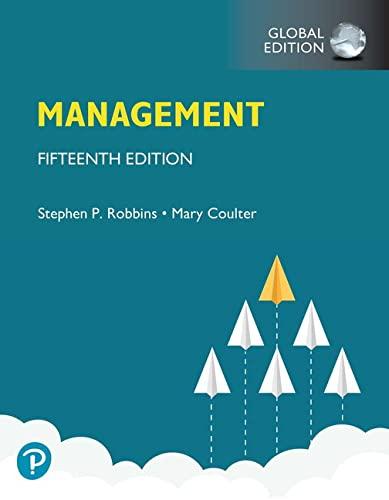Question
based on the tables and text of the case, quantitatively estimate the extent of Walmart's competitive advantage in discount retailing relative to its competitors. Be
based on the tables and text of the case, quantitatively estimate the extent of Walmart's competitive advantage in discount retailing relative to its competitors. Be as specific as possible.
Discount retailing in the US began in the mid-1950s with operators selling general merchandise in sparsely furnished stores. By the end of the 1960s, format sales had grown to $28 billion, surpassing department stores' $20 billion. However, sales stagnated during the 1970s due to a difficult economic climate, leading to many chains going bankrupt. The 1975 ban on resale price maintenance allowed large, no-frills retailers to penetrate the market, causing a 20% decrease in retail establishments. By 1981, discount retailing generated $66 billion in sales, with Kmart becoming the largest and Wal-Mart the second largest.
In the 1980s, growth in the discount retail industry resumed at a more modest rate than in the 1960s, driven by innovations such as denser displays, point-of-sale systems, and UPC scanning. The 1980s also saw the first experiments with hypermarkets, a giant European format that combined general merchandise and grocery items. Wal-Mart and others, including Kmart and Target, evolved a smaller format, dubbed the supercenter, which grew to account for more than $100 billion in sales by 2001 and blurred the traditional boundaries between discount retailers and supermarkets.
The number of discount retailers declined, with the casualties including Kmart in early 2002 in the biggest retail bankruptcy ever. Concentration in the supermarket category increased significantly in the late 1990s due to a wave of mergers and acquisitions. Wal-Mart Stores, Inc. was headquartered in Bentonville, Arkansas, and at the end of fiscal year 2003, it operated 4,688 stores with a total area of 561 million square feet. Wal-Mart commanded as much as 30% of the U.S. market in a number of household staples such as disposable diapers and shampoo.
For fiscal year 2004, Wal-Mart planned to spend $11 billion in capital, much of it to add 48 million square feet in 465 new stores, 335 in the United States and 130 in other countries. Comparable store sales growth rates had recently averaged 5%-6% for the key domestic formats.
Founder Sam Walton, born in 1918 and raised in Missouri, was an energetic and driven individual who began his entrepreneurial ventures at J.C. Penney. He opened his first store in 1945, a small variety format franchised from the Ben Franklin chain. By the beginning of the 1960s, Walton's chain had become the largest Ben Franklin franchisee and the largest independent variety store operator in the United States but its absolute scale of operations remained modest.
In 1962, Sam and his brother Bud opened the first Wal-Mart Discount City store in Rogers, Arkansas, an attempt to make the discount format work in a much smaller town than suggested by conventional wisdom. However, there were weaknesses, as David Glass, a rising financial star, recalled the opening of the second Wal-Mart store as the worst retail store he had ever seen.
Sam Walton passed away in 1992, and his eldest son, S. Robson Walton, was named chairman of the board of directors. However, no family members were actively involved in managing Wal-Mart, although the family held about 38% of the equity in the company. David Glass took over as CEO from Walton in 1988, and under him, Wal-Mart's revenues grew from $20 billion to nearly $200 billion. Lee Scott took over as CEO from Glass, who had also played a key role in developing Wal-Mart's distribution network before holding top-level positions in merchandising and store operations.
In the United States, Wal-Mart stores were grouped into Division One (comprising Discount Stores, Supercenters, and Neighborhood Markets) and SAM's Clubs. Outside the United States, retail formats varied by country and were grouped under Wal-Mart's International Division. The Discount Store format continued to account for the largest number of Wal-Mart stores, but total domestic numbers and square footage had peaked in 1995 and then declined with the conversion of many such stores to Supercenters.
Walmart introduced the Supercenter in 1988, with the intent of driving increased traffic to the general merchandise departments through the food offering. By 2003, fully 42% of the total U.S. population, or 118 million people, had access to a Wal-Mart Supercenter. In 2001, 7% of the Supercenters sales growth came from new shoppers and 21% from existing shoppers who increased their purchase volume.
Neighborhood Markets allowed Wal-Mart to enter space-constrained suburban areas as part of its effort to pack ever more stores into a domestic market of relatively fixed size. Introduced in 1998, these smaller stores, dubbed smallMarts, focused on groceries but also offered limited lines of general merchandise, drugstore items, and photo processing.
SAM's Clubs, introduced in 1983, were warehouse clubs that constituted a separate organizational division at Wal-Mart. Kevin Turner, brought over from Supercenters to become the president and CEO of SAM's, explained its plans for 2003: "Our focus will not be on becoming the dominant club but on being profitable at a lower volume rate." Walmart.com generated about $100 million in 2003 and improved Wal-Mart's access to higher-income consumers and helped drive store traffic.
Step by Step Solution
There are 3 Steps involved in it
Step: 1

Get Instant Access to Expert-Tailored Solutions
See step-by-step solutions with expert insights and AI powered tools for academic success
Step: 2

Step: 3

Ace Your Homework with AI
Get the answers you need in no time with our AI-driven, step-by-step assistance
Get Started


